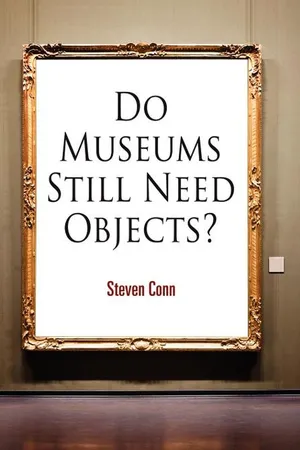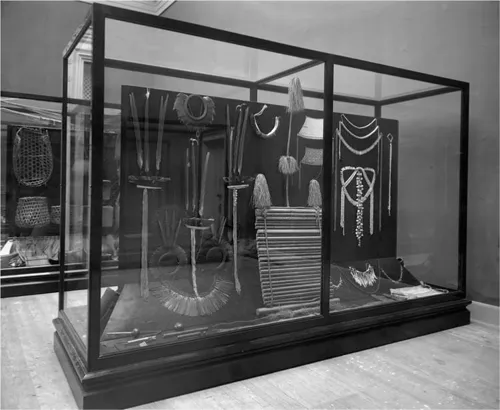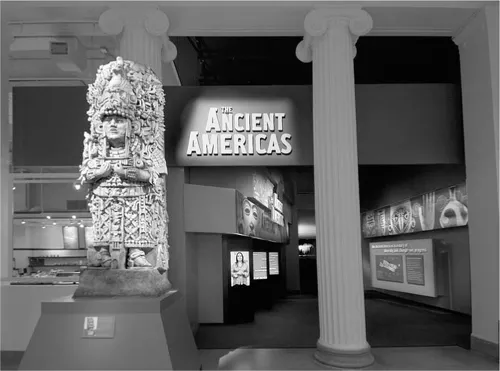![]()
Chapter 1
Do Museums Still Need Objects?
In the introduction I visited briefly the politics of museums, or more properly the political lenses through which scholars have viewed museums. Here, I want to move from that abstract level to the most specific and basic component of the museum: the object. The purpose of this chapter is to sketch what happened to objects in different kinds of museums throughout the twentieth century.
Though the definition of what a museum can be has grown elastic over the last generation, according to the AAM objects are what they all have in common. The organization’s Code of Ethics for Museums notes that all museums make a “unique contribution to the public by collecting, preserving, and interpreting the things of this world.” What I suggest is that while museums as institutions continue to enjoy considerable civic and cultural authority, and while they are lauded more and more for their economic prowess, the use of objects inside them has changed significantly. In some cases, objects continue to play a central role in the function of the museum; in others, their role is clearly a reduced one; in still others, objects have virtually disappeared from galleries, replaced by other didactic devices—audio-visual, interactive technologies, and so on.
If the museum, etymologically speaking, is a place of the muses, then the connection between objects and muses goes back at least to the Renaissance. The potted history of the Western museum goes like this: The museums of today trace their origins back to the princely collections and cabinets of curiosities assembled in early modern Europe. Starting in the eighteenth century, the institutional settings for those collections began to change. Private collections became public—most spectacularly at the Louvre—and what was perceived as the irrationality of the cabinet became rationalized. In the United States, Peale’s museum in Philadelphia represents a critical development, organizing as it did the natural and human world and putting it in the service of a nascent nationalism.
These twin drives toward increased public access and increased rationality culminated, certainly in the United States, in the creation of the great civic museums of the late nineteenth and early twentieth centuries. This amounted to more than mere institutional rearrangements, of course, but represented important intellectual shifts as well. As Stephen Bann has observed, “Paradigms of knowledge themselves shifted, over the period between the Renaissance and the late nineteenth century, in such a way as to ensure that collections of objects acquired a new epistemological status, while being simultaneously adapted to new forms of institutional display.”1
That epistemological shift was driven by what I might call a categorical imperative. Museums in this era prided themselves on their rational organization into categories and departments. They beautifully reflected Durkheim’s observation that a society orders the world of things to reflect the way it orders everything else.2 This was true at both the intramuseum and intermuseum levels. No individual museum could fulfill its mission to educate and uplift unless its collections were organized in “scientific” ways. Likewise, museums could not make rational sense out of the world unless they devoted themselves to collecting, organizing, and displaying particular categories of knowledge.
This is the intellectual context in which the Smithsonian’s George Brown Goode outlined his six-part museum plan discussed in the introduction.3 Taken together, Goode suggested, these six constituted a kind of encyclopedia set of institutions and represented the categories of knowledge that could be given museum form. In this logic, the objects collected and displayed in each museum stood as synecdoches for the larger body of knowledge, and ideally the correspondence between that body of knowledge and the objects on display would be seamless. And as I mentioned earlier, with the exception of commercial museums, these categories have proved remarkably enduring over the last century. (In the United States, only Philadelphia built a Commercial Museum, and it lasted as such only until the 1930s. I discuss the rise and fall of the Philadelphia Commercial Museum in Chapter 5.) (In its most recent guide, the AAM has added zoos to Goode’s list, and it has modified history museums into historic sites. Curiously, zoos have not yet been studied much by scholars, though zoos and natural history museums did share specimens, in a slightly macabre way.)
In this chapter, I follow Goode’s conception as a guide to see what happened in the twentieth century to the objects that were used by museums to constitute those categories. I start with some preliminary observations and generalizations and then visit art museums, anthropological collections, history museums, and science museums of two kinds, natural and technological.
This means that, although the very notion of the categorical museum has expanded remarkably, I won’t consider places like the Mustard Museum in Mount Horeb, Wisconsin, or any of the nation’s museums of barbed wire—there are at least three—save to say that they too aspire exactly to encyclopedic collection, organization, and display of their particular category of “knowledge.” Yet while we continue to categorize museums in a way that reflects their late nineteenth-century origins, the relationship between categories of knowledge and the objects that were once thought to constitute them has certainly changed a great deal. At the same time, objects have lost pride of place in many museums because they aren’t necessary to fulfill some of the functions we now expect museums to perform. If in the late nineteenth century museums were conceived of as primarily places to display objects, by the turn of the twenty-first century it had become possible to imagine museums without any objects at all.
Vanishing Acts?
The first way to answer the question of whether museums need objects anymore is, naturally, to qualify it. While all museums at the turn of the twentieth century conceived of themselves as places to display objects, over the course of that century it became clear not only that different kinds of museums require different kinds of objects but also that they make use of objects in very different ways. Thus some museums, such as those exhibiting art, continue to need objects to do what they do; others, such as science and technology museums, don’t exhibit objects as much as they invite visitors to interact with them; still others, such as those devoted to history in some sense, may or may not require objects at all to convey the messages they want visitors to absorb.
Still, with that said, the first observation we ought to make is that over the course of the last one hundred years, the place of objects in museums of all kinds has shrunk dramatically. Museum exhibits of whatever sort make use of far fewer objects than was the case at the turn of the twentieth century. While I can’t quantify this in any rigorous way, even the casual observation of old photographs and the reading of old museum guidebooks reveal that the galleries have simply become less crowded with stuff. Art museum walls that once hung floor to ceiling, in what is often referred to as “salon” style display, now only exhibit in a single horizontal line, known as the “modernist” approach; natural history specimens displayed in an endless collection of glass cases have been replaced first with dioramas and more recently with interactive technology.
As Stephen Weil, formerly of the Smithsonian, has written, over the last fifty years or so the American museum has changed from “an establishment-like institution focused primarily inward on the growth, care, and study of its collections” to one with “its focus outward to concentrate on providing primarily education services to the public.”4 Museums in the nineteenth century, of course, provided education to the public as well, and museums today continue to care for their collections, but Weil is largely right in noting a shift in emphasis. The museums of the late nineteenth century used a strategy of visual abundance to underscore whatever story they set out to tell. Now visitors are asked to look at fewer objects altogether.
This raises at least three sets of related questions. First, if they are no longer on display, where did all those objects that we can see in the photos from the late nineteenth and early twentieth centuries go? Some reside in study collections, which art museums began to put together by the mid-twentieth century and which are often accessible to visitors. Presumably, however, much more has been sent to the basement or exiled to an off-site storage facility. In a sense, museums have created alternative museums with the bulk of material they don’t exhibit, a parallel museum universe, access to which is generally quite restricted. And yet we know very little about that world not on display, at least not as much as we know about the famous collections that are. What can these other “museums” tell us about changing tastes, about notions of value and authenticity? What ethical questions do they raise about acquisition, preservation, de-accessioning, and public trust? These museum basements may represent for museum scholars a vast undiscovered country.
Second, the reliance on fewer objects in museum galleries and exhibit spaces poses questions about the work those objects are being asked to do. Museum exhibits still use objects to tell stories, but with fewer objects to tell those stories, each object must do more of the telling. What’s more, fewer objects mean fewer opportunities for alternative stories to compete. When museum galleries were stuffed to the rafters with objects, they certainly conveyed a narrative, but with so many objects filling our visual field there well may have been more space for the accidental or unintentional for visitors. Even as museums have worked hard to promote differing points of view in their exhibits, serendipity has been replaced with carefully chosen curation. The smaller number of objects in museums now raises questions about the rise of the curatorial profession, about the relationship between museum curators and other professionals within the same disciplinary fields, and about the expectations that museums now have about the effectiveness of objects to tell stories.
Figure 4. Natural history exhibits old. Cases of objects, like these from South America, characterized natural history museums at the turn of the twentieth century. © The Field Museum, #CSA11897.
Finally, we should ask what is filling up museums nowadays if objects are not. As I pointed out earlier, museums new and old went on a building binge at the end of the twentieth century, and while I have not pulled out a tape measure, it is probably correct to say that object displays occupy less space, as a percentage, than they did at the turn of the last century. As has been well noted, museums now include gift shops, casual cafés, high-end dining, and a host of other spaces devoted to functions other than the display of objects. Museums, so the argument goes, need these spaces to keep up with the demands of a commercial culture, and to take advantage of a consumer economy, but between lunch in the cafe, holiday shopping in the store, and ajazz performance in the atrium, it isn’t clear how much time visitors have to engage with the objects on exhibit.
Figure 5. Natural history exhibits new. A century later, those cases had largely been replaced. An example is this entrance to the Central American exhibit that opened in 2008 at the Field Museum. © The Field Museum, #GN90960_002Cd.
My sense, however, is that objects began to lose their centrality inside museums much earlier than the arrival of gift shops and film series. Museums at the turn of the twentieth century were built on the assumption that visitors would receive an education by visually engaging with objects—lots of objects, with little else to distract visitors from looking at them. That was the ideal, at any rate. Almost immediately, some museums began adding more explanatory labels, charts, and graphs to help visitors reckon with the objects on display.5 Thus did the eternal debate within the museum world—about how much text is the right amount of text—begin. Certainly by the second quarter of the twentieth century at least, that faith in the ability of objects to communicate meaning easily and transparently had eroded further. By the 1920s and 1930s increasing numbers of museums were adding educational programming to their activities and hiring educational specialists to provide it to the public. The objects needed help.
As educational programming grew in institutional importance, objects receded. Dorothy Canfield Fisher, for one, saw this as a positive development. As museums learned more and more to cater to their visitors, they put less and less on display. “The old method,” she observed in 1927, “of putting on view everything the museum contained was seen to be not only a sin against the very essence of art, but wholly unadapted to the limited powers of human attention.” More recently, she believed, “the hideous ideal of mere size, mere numbers, began to disappear. The conception began to take shape that it might be better to thin out the hundreds and thousands of slightly varying specimens to a few, suitable for a general view of any given subject or period, and to put the rest away in archive-storage-rooms, where they could be consulted by students, the only people who really needed to see them.”6
The disappearance of objects, then, corresponds with the rise of other kinds of activities inside the museum and might prompt some questions about the relationship between those activities—educational, recreational, commercial—and the objects themselves, and how those relationships have changed over time.
These are just a few generalizations and observations with which to start. What I propose now is a quick jog through specific kinds museums—almost exclusively American—to see what has happened to the objects inside them.
Art Still Triumphant
On the face of it, the relationship between art objects and art museums would seem to be the most stable over the last century. Even if there are fewer of them on the walls, art objects continue to function largely as they did when American art museums began filling up with collections one hundred years ago. They remain, by and large, invested with the “aura” that Walter Benjamin described in 1937; their power continues to trade on what Igor Kopytoff has called “singularity.” As he defines that idea, “Singularity, in brief, is confirmed not by the object’s structural position in an exchange system, but by the intermittent forays into the commodity sphere, quickly followed by reentries into the closed sphere of singular ‘art.’”7 Singularity and authenticity remain at the core of what “art” means, just as they did a century or more ago.
It is certainly the case that the relationship between art objects in museums and the market for art objects as commodity remains mutually reinforcing, and art museums generate fierce controversy when they propose to put objects back into the art market. One has only to remember the events of 2007 at Randolph College and Fisk University when each tried to sell off substantial portions of their art collections to raise cash, or the decision made by the Albright-Knox Museum to sell certain collections in order to strengthen others. Put in Kopytoff’s terms, de-accessioning upsets many because, by selling off a singular work of art, the museum allows the piece to make one of those “intermittent forays into the commodity sphere” for the financial gain of the institution.
This is so despite numerous predictions and attempts over the twentieth century to undermine, challenge, or reject how art objects function and how they are defined. After all, Benjamin’s essay was itself a prophecy of sorts that the “age of mechanical reproduction” would eliminate the aura that clun...


